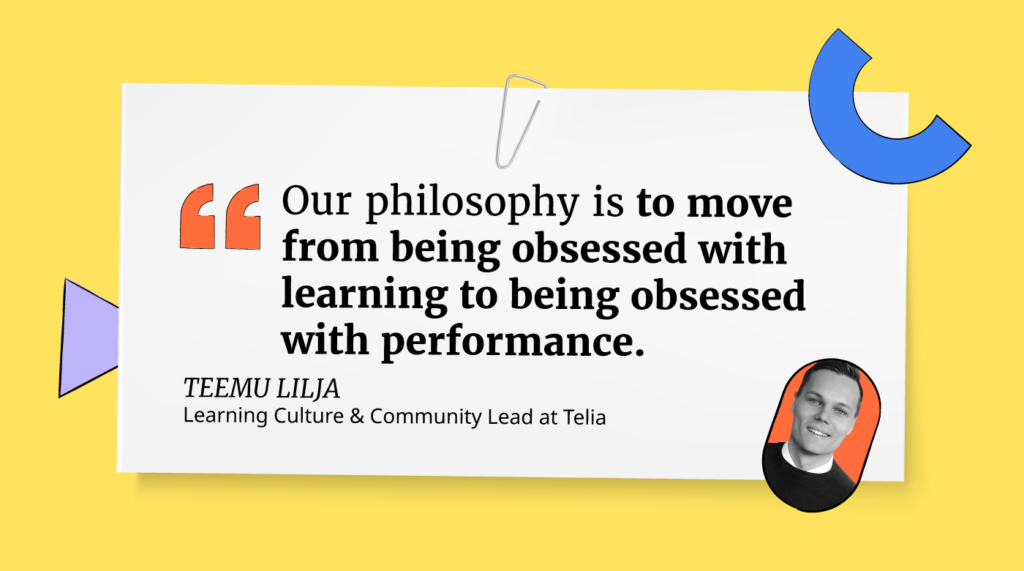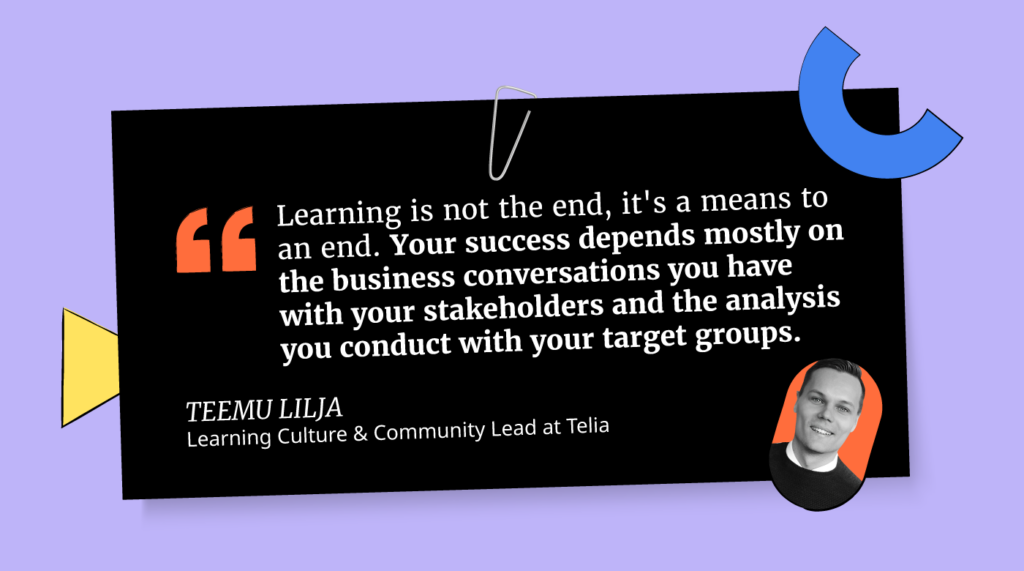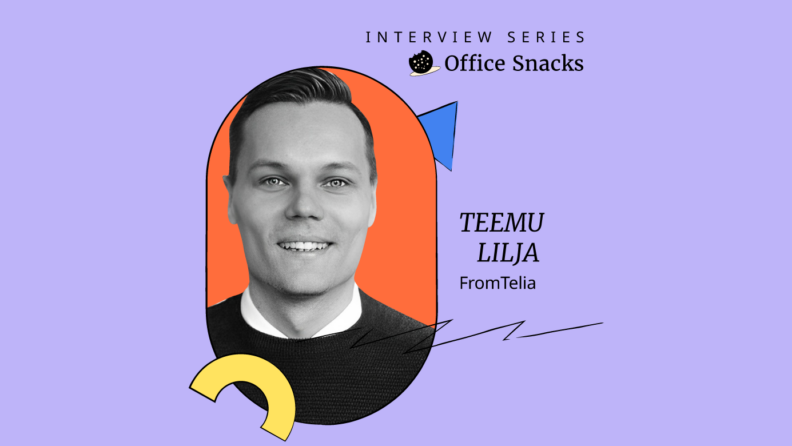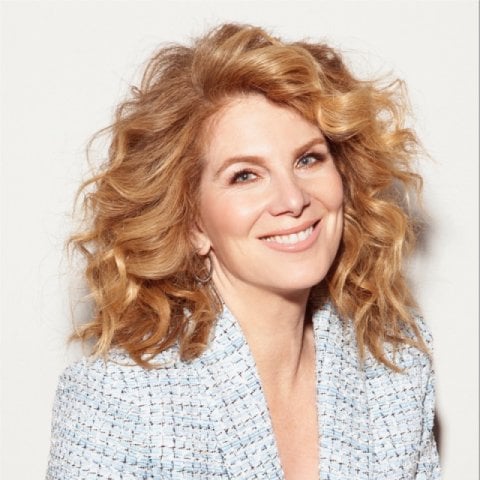In our Office Snacks series, we interview members of our community to delve into their varied buffets of experience and come away with juicy insights and ideas.
Hi Teemu! We’d love to get to know you a bit better, where are you based?
I was born and raised in Stockholm, the beautiful capital of Sweden.
How’d you get to where you are today?
My background is in sales and my journey is a little unusual. I went from being a quite good sales rep, to a quite good sales manager, to a quite good sales coach, to a quite good sales trainer, to running learning for one of Sweden's largest sales-organization.
And now, as of January 2023, I’m responsible for defining and developing the learning culture at Telia and scaling it in all of our markets through communities of practice.
That's the shortened version of my career progress, but I think that what got me here is the team I've been working with and maybe most importantly the leader of our team.
For the past 4 years, we've been pushing for and pivoting from being a very traditional learning team to a performance-orientated team.
This meant going from providing training and administrating learning platforms to actually addressing and solving business problems.
That pivot meant that we fundamentally needed to reinvent and change the way we do learning at Telia. We did it, and it was not easy, but it was worth it!
How does your typical day look, do you have a set routine?
I basically have three main focus areas. Stakeholder management, change management, and also being involved in high-priority transformation projects supporting change and go-to-market streams.
So, a typical day would be back-to-back meetings all day long and working on my actions all night long... not really, it’s not that horrible!
I have routines so I don't just sit in meetings all day and can be the best version of myself both at work and, most importantly, at home for my wife and two kids at home.
I block time every morning to leave the kids at preschool as late as possible and prepare for the day. I also block time every lunch to eat, take care of myself, and get some fresh air or exercise. And I block time every evening to work on the actions I’ve got during the day. Between these, there are a lot of meetings.
It looks pretty boring when reading it, but it works for me!
How do you describe your job to others?
That's actually a tricky one because there is this old perception of automatically connecting the word learning to training. And the tricky part is to convince people it isn't.
I like the sound of being a “problem solver”, but, in the end, I've always described my job as helping people to perform their jobs better.
Whether that is by improving the performance of a specific role, or process, or supporting implementations of some kind. For those purposes, we have a set of tools, and training can be one of them.
I haven't really come up with an elevator pitch for my new role, but maybe a good enough description could be that I orchestrate how the people of Telia learn on the job.
What’s your favorite part of your job?
I find two moments very satisfying. One of them is when we've done a great end-to-end job where we can show the demonstrable impact of our initiatives after defining a real business problem, analyzing it thoroughly, designing and developing the right resources or experiences to address it, and then running a pilot that in the end actually solved the problem. That’s an amazing part of my job.
Another favorite part of my job, which is connected to the first one, is hearing the “Ahaaaaa” from my team members or stakeholders when our efforts actually solved a problem. You know, the moment when they just get why we do things differently nowadays.
The best aha-moment comment from one of my colleagues is “Teemu, now I understand that everything we've done so far has been crap!”. That kind of comment is gold because that shows progress in our mindset shifts.
What’s the most challenging?
The most challenging has definitely been to get everyone on our own team on board because what we've done is a massive change in both what we do and how we do it.
Even though this pivot to performance (more on this next) is a no-brainer for me, it was new for all of us and it's not necessarily what people signed up for or what makes them tick.
I mean, if I like building PowerPoint presentations and standing in front of a classroom all day, and my happy sheets are telling me that I'm doing a great job and I feel important, then my motivation to change that could be pretty low.
Building that motivation or desire to change and actually believing in it is an individual process. You can try to influence it and support people through it… but you can't force it.
It takes time and, even though I understand and respect that process, it has been both challenging and frustrating because we need everyone on board to deliver on what we just promised our stakeholders.

How do you approach learning and development at Telia?
My fundamental belief is that learning and development are just a part of a process. The end goal is not the learning or the development itself, that's a means to an end.
I mean, we learn and develop so that we can do something more effectively or efficiently on the job, right? Or so we can do totally new things at work.
The key word here is “do” and that “doing” always ends up increasing or decreasing some kind of performance indicator that is of importance to the business.
Our philosophy is to move from being obsessed with learning to being obsessed with performance.
This mindset shift alone changes everything.
It gives us no choice but to come close to the business, dig deep into problems, and understand the workflows of our target groups and the tasks that are being done in those workflows. So we put a lot of effort into defining the scope, the end goal, and basically collecting and analyzing data before doing anything else.
That work gives us clarity of what the problem actually is and some kind of hypothesis of what could possibly solve the problem.
The next step is to run experiments in pilot groups, measure the outcomes against reference groups, and iterate from what we learn until we see the desired outcomes on the KPIs we set out to improve.
We promise to create measurable and meaningful business impact and to deliver on that promise. We cannot only exist on a strategic level, creating one-size-fits-all programs with generic content and prove our value in adoption or happy sheets.
Instead, we need to organize ourselves with roles and responsibilities in a way that enables us to do the necessary work. And we need to have people in those roles with the right skills to do it.
As the person responsible for learning culture and communities, I decide what common methodologies we use throughout our processes and create awareness, desire, knowledge, ability, and reinforcement locally to scale a common way of working in our learning community of practice.
I have one full-time colleague working with impact and insights to help us follow the overall progress of the shift in methodologies and create a common framework with resources for scaled local adoption of how to conduct relevant analysis.
I have one colleague working full-time on creating a learning tech ecosystem to enable and reinforce our common methodologies and learning culture. This person is a solid software developer, which makes us not as reliant on IT to make integrations or necessary development.
We have a couple of people working on improving our own processes such as automating manual steps and integrating different tools with each other. We need to free up time to do even more great stuff!
We also have an internal digital production team working with audio and video production, animation, e-learning production etc. Basically designing and developing content for learning experiences or resources.
And we have business partners, or performance consultants, working close to our different markets and leading the learning streams in locally prioritized projects and initiatives.
We believe that this setup enables and supports all the different steps in 5Di, which is the fundamental process we follow. Every step of the process requires a different set of skills and can be reinforced by different sets of technologies.
What’s been your most successful initiative to date?
It depends on the definition of success, but one great example is when a stakeholder from retail ordered training for all store employees on our check-out system.
The defined problem was that people were making errors when creating customer receipts, which lead to a lot of time correcting the receipts in the back office afterward.
Analysis showed that the check-out system itself was easy to use, but the sales reps thought that it was complicated to understand. The different article number combinations were hard to remember and time-consuming to find on the intranet.
So what we ended up doing was making the document easier to understand, developing a link into the check-out system at the moment where people need to find the article numbers and combinations, and setting up a blocker for people to just discount something on receipts.
So, basically, making people need to find the combinations and have the performance support one click away. We tried it out… zero training… but zero mistakes made after that

What’s the biggest misconception about learning and development?
Probably that we’re only capable of delivering training and that what we do is not measurable in business KPIs. But, then again, that's not a misconception. Those expectations are just consequences of what we've done before.
Which are your most-loved tools that help you with your job?
If I can talk about methodologies as tools, which I think they are, then I would say ADKAR, 5Di, HPLJ, and 5MoN as the best tools ever created. But if that's too high-fly then any of the resources for any of the methodologies are great tools!
What’s your number one piece of advice for organizations starting out with L&D?
It would be to start with the end in mind. Learning is not the end, it's a means to an end. Your success depends mostly on the business conversations you have with your stakeholders and the analysis you conduct with your target groups.
The rest is easy!
Lastly, and most importantly, what’s your favourite office (home or otherwise) snack?
Beer sausage (not sure if it's called that in English, but it's these long, thin spicy sausages). They are just amazing!
What’s your favorite office snack?
Work in People and Culture? Want to share your ideas?
Applications to be interviewed are open to anyone (yes anyone!) so don’t hesitate to fill in the form for an opportunity to share your knowledge and ideas.




